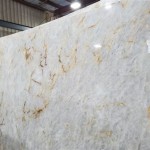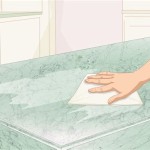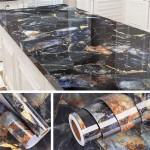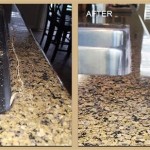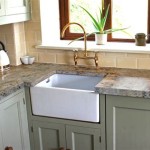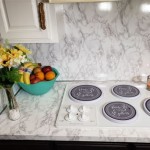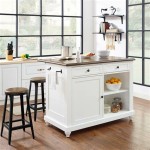Peel and Stick Countertop Wood: A Comprehensive Guide
Peel and stick countertop wood, also known as self-adhesive wood veneer, has emerged as a popular and accessible solution for homeowners and renters seeking to upgrade their kitchen or bathroom countertops without the expense or hassle of traditional countertop replacement. This innovative product offers a cost-effective and relatively simple way to achieve the aesthetic appeal of real wood on existing surfaces. However, understanding the properties, benefits, limitations, and proper application techniques is crucial for ensuring a successful and long-lasting result.
This article provides a comprehensive overview of peel and stick countertop wood, exploring its composition, advantages, disadvantages, installation process, maintenance requirements, and considerations for different applications. The goal is to equip readers with the necessary knowledge to make informed decisions regarding the use of this material in their home improvement projects.
Understanding the Composition and Varieties
Peel and stick countertop wood typically consists of a thin layer of real wood veneer or a high-quality wood-look laminate adhered to a self-adhesive backing. The wood veneer option utilizes a thin slice of natural wood, showcasing the grain patterns and textures inherent in the species. The laminate option, on the other hand, uses a printed image of wood grain laminated onto a durable substrate, often vinyl or PVC. Both types are designed to mimic the appearance of solid wood countertops.
The adhesive backing is a key component. It is generally a pressure-sensitive adhesive (PSA) designed to create a strong bond with the existing countertop surface. The quality and strength of the adhesive will significantly influence the product's longevity and resistance to peeling or bubbling. Some products feature repositionable adhesives, allowing for easier adjustments during installation, while others offer a more permanent bond.
A wide variety of wood species and finishes are available in peel and stick countertop wood. Oak, maple, cherry, walnut, and pine are common choices for real wood veneers, each offering unique color variations and grain patterns. Laminate options can replicate virtually any wood species, including exotic and reclaimed wood looks. Furthermore, a range of finishes, from matte to high-gloss, allows for customization to match existing décor and personal preferences.
Advantages of Peel and Stick Countertop Wood
The primary advantage of peel and stick countertop wood is its ease of installation. Unlike traditional countertop installations, which often require professional assistance and specialized tools, applying self-adhesive wood veneer can be undertaken by most homeowners with basic DIY skills. The process typically involves cleaning the existing surface, measuring and cutting the veneer to size, peeling off the backing, and carefully adhering the material to the countertop. This simplicity translates to significant cost savings by eliminating labor expenses.
Cost-effectiveness is another major draw. Peel and stick countertop wood is generally much less expensive than solid wood, engineered wood, or even laminate countertops. This makes it an attractive option for budget-conscious homeowners, renters, or those seeking a temporary countertop upgrade. The affordability allows for experimentation with different styles and finishes without a significant financial commitment.
Aesthetic enhancement is a key motivator for choosing peel and stick countertop wood. It offers a quick and dramatic transformation of outdated or worn countertops, adding warmth, character, and visual interest to the kitchen or bathroom. The availability of various wood species, finishes, and patterns allows for customization to suit different design styles, from rustic and farmhouse to modern and contemporary.
Another benefit is the minimal disruption caused during installation. Unlike extensive countertop replacements that can render the kitchen or bathroom unusable for days, applying peel and stick wood veneer can often be completed in a matter of hours. This reduces inconvenience and allows for a quicker return to normal household activities.
Peel and stick options are also a viable solution for renters. Since it is relatively easy to remove, it allows for personalizing a rental space without causing permanent alterations, avoiding potential conflicts with landlords. Upon moving out, the veneer can be carefully peeled off, restoring the original countertop surface (provided the original surface is durable and properly prepared).
Limitations and Considerations
While peel and stick countertop wood offers numerous advantages, it is important to acknowledge its limitations. Durability is a key concern. Compared to solid wood or high-quality laminate countertops, self-adhesive wood veneer is generally less resistant to scratches, dents, heat, and moisture. This is particularly true for thinner veneers or lower-quality laminate options. Proper care and maintenance are essential to prolonging its lifespan.
Moisture resistance is another crucial factor to consider. While some peel and stick countertop wood products are treated with water-resistant coatings, they are not completely waterproof. Prolonged exposure to water or spills can cause the adhesive to weaken, leading to peeling or bubbling. It is crucial to wipe up spills immediately and avoid using harsh cleaning chemicals that can damage the finish. Areas around sinks and faucets are particularly vulnerable and may require additional sealing or protection.
Heat resistance is also limited. Placing hot pots or pans directly on peel and stick countertop wood can cause scorching or discoloration. It is always recommended to use trivets or heat-resistant mats to protect the surface from heat damage. The specific heat resistance of a product will vary depending on its composition and thickness, so it is important to consult the manufacturer's specifications.
Surface preparation is critical for a successful installation. The existing countertop surface must be clean, smooth, and free of any dust, grease, or debris. Any imperfections, such as cracks or dents, should be repaired before applying the veneer. A poorly prepared surface can compromise the adhesion of the veneer and lead to premature failure.
The quality of the adhesive is a determining factor in the product's long-term performance. Lower-quality adhesives may lose their bonding strength over time, resulting in peeling or lifting. It is advisable to choose products from reputable manufacturers that use high-quality adhesives designed for countertop applications.
Seams can be a potential weakness point. When covering large countertop areas, multiple pieces of veneer may be required, resulting in seams. These seams are susceptible to moisture penetration and can be visually noticeable. Proper sealing and careful alignment are essential to minimize these issues. Consider using color-matched caulk or seam fillers to create a more seamless appearance.
Installation Process: A Step-by-Step Guide
The installation of peel and stick countertop wood, while generally straightforward, requires careful planning and execution. The following steps outline the recommended process:
Step 1: Surface Preparation: Thoroughly clean the existing countertop surface with a degreasing cleaner to remove any dirt, grease, or wax. Rinse with clean water and allow the surface to dry completely. Repair any cracks, dents, or imperfections with appropriate fillers and sand smooth. For glossy surfaces, lightly sand to create a better bonding surface for the adhesive.
Step 2: Measurement and Cutting: Accurately measure the dimensions of the countertop area to be covered. Add a few extra inches to each dimension for trimming and adjustments. Carefully transfer the measurements to the peel and stick countertop wood, using a straight edge and a sharp utility knife to cut the veneer to size. For complex shapes or curves, create a template using paper or cardboard to ensure accurate cutting.
Step 3: Test Fit: Before removing the adhesive backing, place the cut veneer onto the countertop to ensure a proper fit. Make any necessary adjustments or trimming to achieve a precise fit. Pay close attention to edges, corners, and seams.
Step 4: Application: Peel back a small portion of the adhesive backing from one edge of the veneer. Align the veneer with the edge of the countertop and carefully press it into place. Gradually peel back the remaining backing, working from the center outwards, while smoothing the veneer onto the surface with a plastic smoothing tool or a clean cloth. This will help to eliminate air bubbles and ensure a strong bond.
Step 5: Smoothing and Air Bubble Removal: Once the veneer is applied, thoroughly smooth the surface with a smoothing tool to remove any remaining air bubbles. Work from the center outwards, applying firm and even pressure. For stubborn air bubbles, use a pin to prick the bubble and then smooth the area again.
Step 6: Trimming: Use a sharp utility knife to trim any excess veneer along the edges of the countertop. A straight edge will help to ensure clean and precise cuts. Be careful not to damage the underlying countertop surface.
Step 7: Sealing (Optional): For areas around sinks and faucets, consider applying a clear silicone sealant along the edges to prevent water penetration. Apply the sealant sparingly and smooth with a finger or a sealant smoothing tool. This will help to prolong the lifespan of the veneer and prevent moisture damage.
Maintenance and Care
Proper maintenance and care are essential for preserving the appearance and extending the lifespan of peel and stick countertop wood. Here are some key recommendations:
Regular Cleaning: Clean the countertop regularly with a damp cloth and a mild detergent. Avoid using harsh chemicals, abrasive cleaners, or scouring pads, as these can damage the finish. Wipe up spills immediately to prevent staining or water damage.
Heat Protection: Always use trivets or heat-resistant mats under hot pots, pans, or appliances. Avoid placing hot items directly on the countertop surface.
Scratch Prevention: Use cutting boards when preparing food to avoid scratches. Be mindful of sharp objects that could potentially damage the surface.
Moisture Control: Wipe up spills immediately and avoid prolonged exposure to water. Ensure proper ventilation in the kitchen or bathroom to prevent moisture buildup.
Seam Maintenance: Regularly inspect the seams for any signs of damage or water penetration. Re-seal the seams as needed to maintain their integrity.
Repairing Damage: Minor scratches or dents can often be repaired with wood touch-up markers or wax sticks that match the color of the veneer. For more significant damage, consider replacing the damaged section of the veneer.
By following these maintenance and care guidelines, homeowners can help to preserve the beauty and extend the lifespan of their peel and stick countertop wood, ensuring that it continues to enhance their living spaces for years to come.

Make A Faux Wood Countertop With Peel And Stick Wallpaper Stow Tellu

Make A Faux Wood Countertop With Peel And Stick Wallpaper Stow Tellu

Burl Wood Contact Paper Peel And Stick Countertops Waterproof Light Grain C

Make A Faux Wood Countertop With Peel And Stick Wallpaper Stow Tellu

Make A Faux Wood Countertop With Peel And Stick Wallpaper Stow Tellu

Wood Grain Vinyl Contact Paper Wallpaper Home Decor Self Adhesive

Wood Contact Paper For Countertops Shiplap Peel And Stick Bathroom Kitchen Vintage Grain Self Vinyl Roll 17 71x118 Inches
:max_bytes(150000):strip_icc()/stoweandtellu-67f9f0a6ba4948589578a65f2ec12492.jpg?strip=all)
25 Diy Countertop Ideas To Elevate Your Kitchen

Make A Faux Wood Countertop With Peel And Stick Wallpaper Stow Tellu

White Black Granite Peel And Stick Countertop Vinyl Cover Waterproof L Ezfauxdecor Llc
See Also

